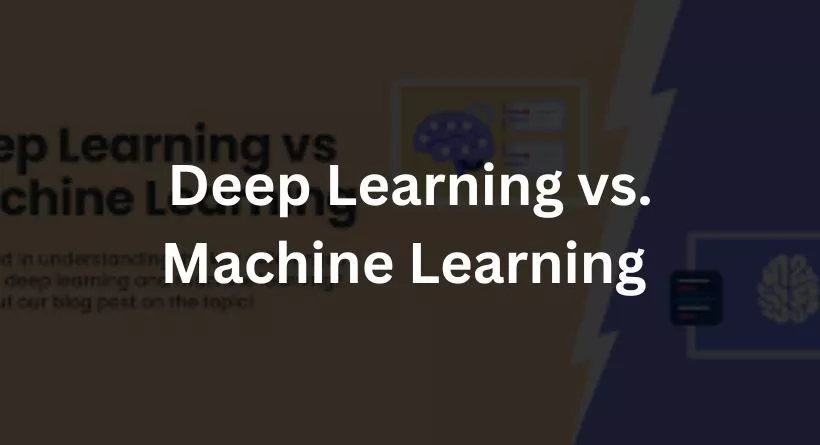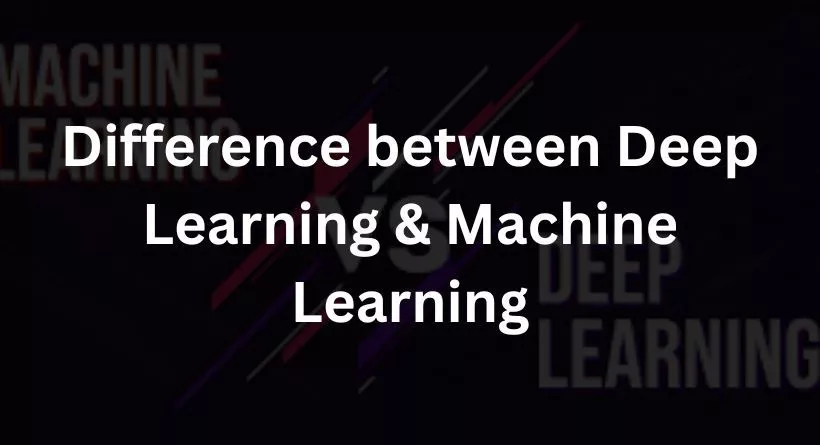
The world of artificial intelligence can be a perplexing one, filled with technical jargon and complex concepts. Two terms that are often used interchangeably, but are distinctly different, are Deep Learning and Machine Learning. In this article, we’ll demystify these terms, exploring what sets them apart and why they matter in the realm of AI.
Understanding the Basics

Deep Learning and Machine Learning? What’s the difference
Machine Learning, at its core, involves computers learning from data through algorithms to perform specific tasks without explicit programming. It’s all about recognizing patterns and making predictions based on the data it’s given. Deep Learning, on the other hand, takes this concept to the next level by using a complex structure of algorithms inspired by the human brain. This allows it to handle unstructured data like documents, images, and text.
You may also like reading: How to Leverage Machine Learning and AI for Small Business
In essence, Deep Learning is a specialized subset of Machine Learning, which, in turn, is a subset of Artificial Intelligence. So, while they’re related, they are not the same thing.
Diving Deeper into Machine Learning

What is Machine Learning?
Machine Learning is the overarching term that encompasses the idea of computers learning from data. It’s where computer science and statistics meet, with algorithms doing the heavy lifting. These algorithms can either be supervised or unsupervised, depending on the type of data they work with.
Consider a simple example: predicting income based on years of education. In this case, a machine learning algorithm, like linear regression, would be used. It starts with defining a function, such as income = y + x * years of education, and then, through a set of training data, learns to make predictions. The key here is that it learns without explicit programming, relying on patterns and statistical inference.
In a nutshell:
- Machine Learning combines computer science and statistics to enable computers to learn without explicit programming.
- The two main broad categories of Machine Learning: supervised and unsupervised learning.
- Machine Learning can range from simple algorithms like linear regression to complex models.
The Deep Dive into Deep Learning

What is Deep Learning?
Deep Learning, as the name suggests, delves into the deep, intricate aspects of machine learning. It employs algorithms that mimic the logical thinking of humans, and it can utilize both supervised and unsupervised learning techniques. What sets it apart is the use of artificial neural networks (ANN), inspired by the structure of the human brain.
An ANN comprises layers: an input layer, one or more hidden layers, and an output layer. The more hidden layers it has, the “deeper” the network is, leading to the term “deep neural network.” This complexity allows Deep Learning to process data in ways that traditional machine learning models can’t match.
Deep Learning’s applications are widespread, from automated driving, where it detects objects, to military use, identifying objects from satellites, and consumer electronics, where devices like Amazon Alexa rely on it to understand and respond to human voices.
Let’s consider a practical example: Tesla using a Deep Learning algorithm to recognize STOP signs. Unlike traditional machine learning, the ANN in this case automatically extracts relevant features from images, like edges, colours, and shapes. It learns from its own errors during training, making it highly capable with minimal human intervention.
In summary:
- A specific subset of machine learning is called deep learning.
- Artificial neural networks are a layered structure of algorithms that are used.
- Deep Learning requires substantial data but minimal human intervention.
- The emergence of transfer learning has made Deep Learning more accessible.
Key Differences
So, what makes Deep Learning special within the realm of Machine Learning?
First, it’s the complex and interconnected structure of artificial neural networks. While traditional Machine Learning algorithms like linear regression are relatively straightforward, Deep Learning’s ANN is intricate, like the human brain.
Second, Deep Learning requires less human intervention. In the case of image recognition for a STOP sign, a traditional machine learning approach would require a software engineer to manually select features and adjust the algorithm. Deep Learning automates this feature extraction and self-correction process.
Lastly, Deep Learning needs more data. While a traditional Machine Learning algorithm can work with thousands of data points, Deep Learning often requires millions due to its complex multi-layer structure. The abundance of data helps eliminate errors and produce higher-quality interpretations.
Got it. But what about coding?
Although deep learning is still in its infancy in many fields, it has already immense potential. Large corporations with abundant financial and human resources are the ones that employ it the most, as developing Deep Learning algorithms was once difficult and costly. However, this is evolving. Everyone should be allowed to create their own unique deep learning solutions, in our opinion at Levity.
You wouldn’t have read this far if you knew how to create a TensorFlow model and execute it over many cloud TPU instances. If you don’t, you’ve come to the correct spot. since we are creating this platform with individuals like you in mind. People who have ideas about the potential applications of AI but lack the technical know-how or time to see such applications through to completion.
Even though I say I know a decent deal about programming, Deep Learning, and even cloud software deployment, I won’t say I could accomplish it in a reasonable length of time. In the event that reading this or any other article has left you hungry, please contact us. We would be delighted to speak with you and are constantly searching for excellent use cases!
Conclusion
In the world of Artificial Intelligence, Deep Learning and Machine Learning are closely related yet distinct concepts. While Machine Learning serves as the foundation, Deep Learning takes things to a more intricate level. These technologies have revolutionized various industries, from autonomous driving to consumer electronics, making AI a ubiquitous part of our lives.
FAQs
1. Are Deep Learning and Machine Learning the same thing?
No, they are not. Deep Learning is a specialized subset of Machine Learning, which is, in turn, a subset of Artificial Intelligence. While related, they have distinct characteristics and use cases.
2. What are the practical applications of Deep Learning?
Deep Learning is used in various fields, including automated driving, military applications, and consumer electronics. For example, it helps identify objects in images, making it invaluable in object detection and classification tasks.
3. How does Deep Learning differ from traditional Machine Learning?
The key differences lie in the complexity of the algorithms used and the level of human intervention required. Deep Learning employs intricate artificial neural networks and requires less manual feature selection, making it more autonomous.
4. Why does Deep Learning require more data?
The complex multi-layer structure of Deep Learning models necessitates a large dataset to eliminate errors and produce reliable results. While traditional Machine Learning can work with smaller datasets, Deep Learning benefits from vast amounts of data.
5. What is transfer learning in Deep Learning?
Transfer learning is a technique that allows Deep Learning models to leverage pre-trained models, reducing the need for massive training datasets. It has made Deep Learning more accessible for various applications.





